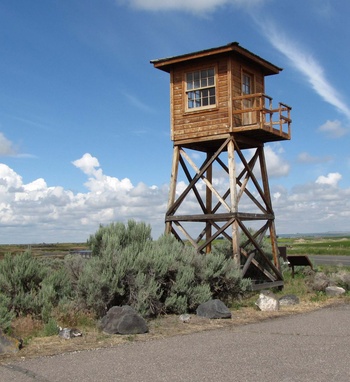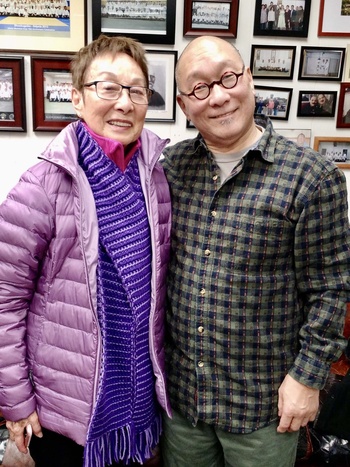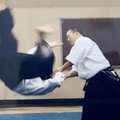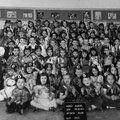Though not, perhaps, in the way one might think given his martial arts bonafides, in 1950 Chicago native Andrew Masaru Sato—7th dan aikido shihan—was born into a martial lineage. His Nisei father, Noboru “Norman” Sato, was a WWII combat veteran of the U.S. Army’s 100th Battalion of the 442nd Regiment in the European Theater, having been inducted from an American concentration camp.

“You hear that story about your dad saying goodbye to his mom and dad between barbed wires, wearing the same uniform as the guard up in the tower,” says Sato, shaking his head. “It’s pretty rough to hear that.”
With family roots in the Japanese prefectures of Niigata and Shiga, Andy Sato’s grandparents sailed to the Pacific Northwest among the early 20th century waves of migrant workers and picture brides. His Seattle born-and-bred parents met at Minidoka War Relocation Center in Hunt, Idaho. As a result of Franklin Delano Roosevelt’s Executive Order 9066 in the wake of Japan’s bombing of Pearl Harbor, in 1942 some 120,000 Japanese Americans—two-thirds of whom were American citizens by birth—were forcibly removed from their West Coast homes and without due process incarcerated across ten prison camps in desolate areas of the U.S. interior.
Former U.S. Secretary of Transportation Norman Mineta, in a UC Berkeley Alumni Association interview about his childhood at Heart Mountain War Relocation Center in Wyoming, recalled, “All 120,000 of us were put in camps behind barbed wire, with guard towers every 300 yards, and searchlights and machine guns. They told us we were in the camps for our own protection. But we said, ‘If we’re in here for our own protection, why are those machine guns pointed at us?’”
In spite of such treatment, many Nisei entered the military service, eager to prove their loyalty—a loyalty put into question purely on the basis of race and ethnic origin. To this day, the 442nd Regimental Combat Team—the segregated Japanese American unit to which the 100th Battalion was attached—remains the most decorated unit for its size and length of service in U.S. military history; and according to General Douglas MacArthur’s intelligence chief, Major General Charles Willoughby, Japanese American linguists of the Military Intelligence Service “saved over one million lives and shortened the war by two years” in the Pacific Theater.
Sato, himself, is a military veteran. In the late 1960s, eager to get ahead of the draft, he preemptively joined the United States Air Force. “I didn’t want to carry a gun,” he says. After basic training at Lackland Air Force base, Sato was sent to Biloxi, MS, in the aftermath of Hurricane Camille. “For the first two-and-a-half weeks there, it was just clean-up. To see tankers (oil tanker ships) two miles inland was crazy.”
Afterward, he was stationed in Belleville, IL. “It was like a nine-to-five job. I spent three months in the Azores Islands during the Middle East oil crisis, that was it. It was pretty much a stateside job. I was supposed to go to Thailand, but those orders were cancelled. I was in there almost four years, came out and on the G.I. Bill did undergrad at Northeastern Illinois University.”
In 1977, the television adaptation of Alex Haley’s novel Roots was aired on ABC as an eight-episode miniseries. Sato reminisces, “A really close friend of mine, who was Hawaiian Japanese American living in Chicago, blew in my ear and says, ‘Hey, go back to the motherland.’”
Inspired, Sato indeed traveled to Japan that very same year and “came back all fired up wanting to do everything Japanese. I realized why so many things were odd for me before, but I couldn’t put my finger on why. After going to Japan, I realized it was because my Japanese side was there and I just didn’t know it.
“JAs,” he says, using the common abbreviation for Japanese Americans, “I think especially in the Midwest, we have a lot of common history but we’re not connected. Our parents tried to have us assimilate and be as White as apple pie. It worked to some degree, but in the process we lost so much of our culture.

“So, I came back and wanted to do something to keep the culture. I was going to a church at the time, and some women there were taking aikido. Sada Hatanaka and Rose Kaihatsu were the two women who were really instrumental in my trying aikido. They said, ‘Why don’t you come?’ At the time, Toyoda sensei offered one free trial lesson. I took that, signed up at the end of class, and never left. That was in December of ‘77.
“I was training seven days a week, working and then just going to the dojo. At that time, sensei had three classes a night, Monday through Friday. I went to all of them. And Saturday and Sunday we had classes, too. He had a lot of guys from Japan, they were his deshi. He had about four or five of them. They were all sandan, yondan, and young. I was their whippin’ boy. But I loved it because I was learning aikido, learning the culture, and I was really trying to immerse myself as best I could short of going to Japan.”
Aikido, like kendo, judo, and karatedo, is counted among Japan’s gendai budo, or modern martial ways established after the Meiji Restoration of 1868. Founded in the mid-20th century by Morihei Ueshiba (1883-1969), aikido is a distillation of Ueshiba’s lifetime study of various koryu bujutsu, or old schools of martial arts. The main difference between koryu arts and gendai budo are that while the koryu focused on battle-born killing techniques developed through centuries of civil war, gendai ways train these techniques through the lens of a comprehensive philosophy for the building of moral character.
Fumio Toyoda, a native of Tochigi, Japan, had immigrated to Chicago in 1974 to establish a dojo under the direction of his instructor, Koichi Tohei. Tohei, the former chief instructor of Aikido World Headquarters (Aikikai), Tokyo, had priorly introduced aikido to the U.S. via Hawaii in 1953 and had subsequently been instrumental in the founding of schools in Los Angeles in 1956 and Chicago in 1961.
Due to political schisms, in 1974 Tohei left his position as Aikikai chief instructor and started an organization known as Ki Society (Ki no Kenkyukai). Notwithstanding Toyoda having risen through the ranks to become an assistant instructor at Aikikai, loyalty to his original teacher overshadowed organizational politics and he joined Tohei in the establishment of Ki Society.
The Illinois Aikido Club, Chicago’s first aikido dojo founded by a group of Nisei professionals in 1961 and which had once sustained a relationship with Koichi Tohei as chief instructor of Aikikai—having even hosted him in Chicago on a number of occasions—had decided to maintain their affiliation with Aikido World Headquarters. As such, under Koichi Tohei’s leadership, Toyoda founded the Chicago Ki-Aikido Society as a unique entity.
“It started in a little dojo where Halsted, Broadway, and the police station come together,” Sato recalls of the dojo’s beginnings at 3726 N. Broadway in the North Side neighborhood of Lakeview. “There’s a little turn out, a bus station. The building mysteriously caught fire and burned, so then he moved and rented from Mr. Shin, who runs the East West Martial Arts Supply, now up on Western. He had a place at 3249 N. Ashland at School Street, on the second floor. Toyoda sensei rented there from ’76 or so till ’79, and then he bought the place on Belmont and Sheffield and made the Japanese Culture Center.
“I helped with the moving to 1016 W. Belmont, and after we left Ashland it was renovated into a much nicer dojo by the Midwest Aikido Center, Akira Tohei’s group (unrelated to Koichi Tohei), which is now located at Montrose and Damen. The Ashland building is now condos.
“The Japanese Culture Center was quite an organizational thing. Sensei offered tea ceremony, Japanese language, karate, kendo, iaido, I mean he made it all in this little two-flat building. He used the basement, the first floor was aikido, the second floor was for Zen, karate, other programs. He’d gather all these different teachers, pay them, and he’d offer six-week courses. So, he had quite an operation going, meanwhile creating the Aikido Association of America.”
In 1984, yet another political schism found Fumio Toyoda ousted from Ki Society, after nearly thirty years as a loyal follower of Koichi Tohei. Toyoda subsequently founded the Aikido Association of America in 1985 and Aikido Association International in 1991, each headquartered at the Japanese Culture Center. In 1994, he reaffiliated with Aikikai.
© 2024 Erik Matsunaga







